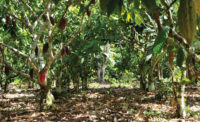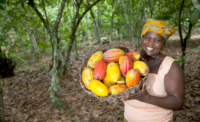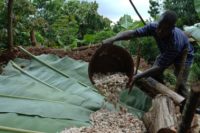It’s not often one comes across a chocolate maker who’s had two previous careers. Sure, it’s not unusual to find someone who’s been a pastry chef or hi-tech entrepreneur in his/her former life. But a psychoanalyst and a gourmet chef combined?
What’s even more surprising is that Samantha Aquim, from Aquim Gastronomia, continues to help run the family catering business in Rio de Janeiro as a gourmet chef. In addition, she also continues to draw upon her education reading and researching therapy.
But her love and passion for premium chocolate decidedly trumps all other professions. And like all true, lasting loves, it wasn’t an immediate seduction. After completing her education in psychology and beginning her career as a psychoanalyst Aquim was drawn to the world of gastronomy.
No surprise since Luiza Aquim, Samantha’s mother, had started a catering enterprise many years ago. Her brother Rodrigo was already involved and it didn’t take much to welcome another family member to the business.
Consequently, she enrolled in the famed French cooking school, Ecole Lenotre. Upon completion, Samantha returned to Rio and opened up a catering storefront. As part of that endeavor, she started to produce chocolates in the French/Belgium tradition, winning several awards along the way.
But it was an encounter with the Fine Cocoa Association that proved to be her chocolate epiphany. It was, as she says using a local Brazilian idiom, “As if I smacked myself with an ice cream cone on my forehead.”
It dawned on Samantha that she knew nothing about cocoa, a situation she immediately decided to remedy.
“In the Brazilian-African religion, you play the drums to ask for help. You have to be brave enough to realize what you don’t know,” she says.
Within a month she went out to visit Joao Tavares, one of Brazil’s famed fine-flavor cocoa farmers, at his Leolinda plantation in Bahia. At the time, he was discovering fine cocoa possibilities. It was there that she began to understand the beauty and complexity of cacao and its transformation into chocolate.
From its jungle rainforest canopy to the smells prevalent in the fermentation house, the Lelinda plantation showcased the birthplace of cacao as no other place could. Samantha took it in as only an artisan chef could, making notes of the aromas of the beans during the various stages of fermentation.
Here was cocoa with personality.
Challenged by Tavares to produce chocolate using his fine-flavored cocoa beans — after all, the Amazon and not Mexico was the birthplace of cacao — Samantha took up the gauntlet. Working with Nugali, a mid-sized manufacturer of premium chocolates, she handpicked the beans and began experimenting with recipes.
As Samantha points out, 99 percent of the chocolate consumed today is what she refers to as bulk chocolate. The remaining 1 percent is made from fine-flavored cocoa beans. And it was her discovery of Brazil’s cocoa heritage that further fueled her passion to produce a truly exquisite piece of chocolate — a piece of chocolate qualifies for that elite 1 percent.
Her first effort, Q-Zero, proved to be a spectacular one. Not content to merely present the chocolate in traditional bar form, she enlisted the help of one of Brazil’s most famous architects, Oscar Niemeyer — the man who designed Brasilia, the country’s capital — in creating a unique shape for her unique product.
The result was an undulating “bar,” edible architecture so to speak, that promised a river of jungle fruit and floral notes. To Samantha, however, the most important confirmation of success came from the plantation workers, who were the first to sample the Q-Zero chocolate.
As she relates, one of them provided her with an imprimatur that she will never forget. After tasting the chocolate, the worker told Samantha, “This is my cocoa, this is the flavor of my life.”
The tasting set, which is made from a single vintage of beans, includes 42 chocolate medallions and three 3.5-oz fluid bars.
As Samantha says, “Q-Zero is the incomparable magic of perfect cocoa beans, one can only be thrilled by the discovery of a new universe of aromas and sensations.”
Those aromas and sensations don’t come cheap; it’s $850 for the tasting kit. Fortunately, Samantha recognizes that not everyone can afford such finesse. As she says, “I want to make my chocolates affordable.”
Her standard Q range comprises six grades of dark chocolate, divided into two subgroups: suaves (50, 60 and 65 percent) and intensos (75, 80 and 85 percent). Each bar contains only three ingredients: cocoa mass, cocoa butter and cane sugar. And, the bars feature colorful eco-friendly packaging that illustrate the flora and fauna native to the Amazon jungle.
Currently, Samantha operates five retail shops in Rio, the only place where the Q-Zero tasting kits are available. Her products are sold at various hi-end outlets in Brazil, as well as shops such as Central Market in Texas and Selfridges; Fortnum & Mason in London; and Le Bon Marche in Paris.
She remains relentless in ensuring the quality of Q Chocolate products, and it is a labor of love. Moreover, she remains an unrelenting spokesperson for the continued development of fine-flavored cocoa in Brazil.
As Samantha points out, “I’m selling knowledge, not chocolate.”
Check out the rest of our Brazilian cocoa content:










